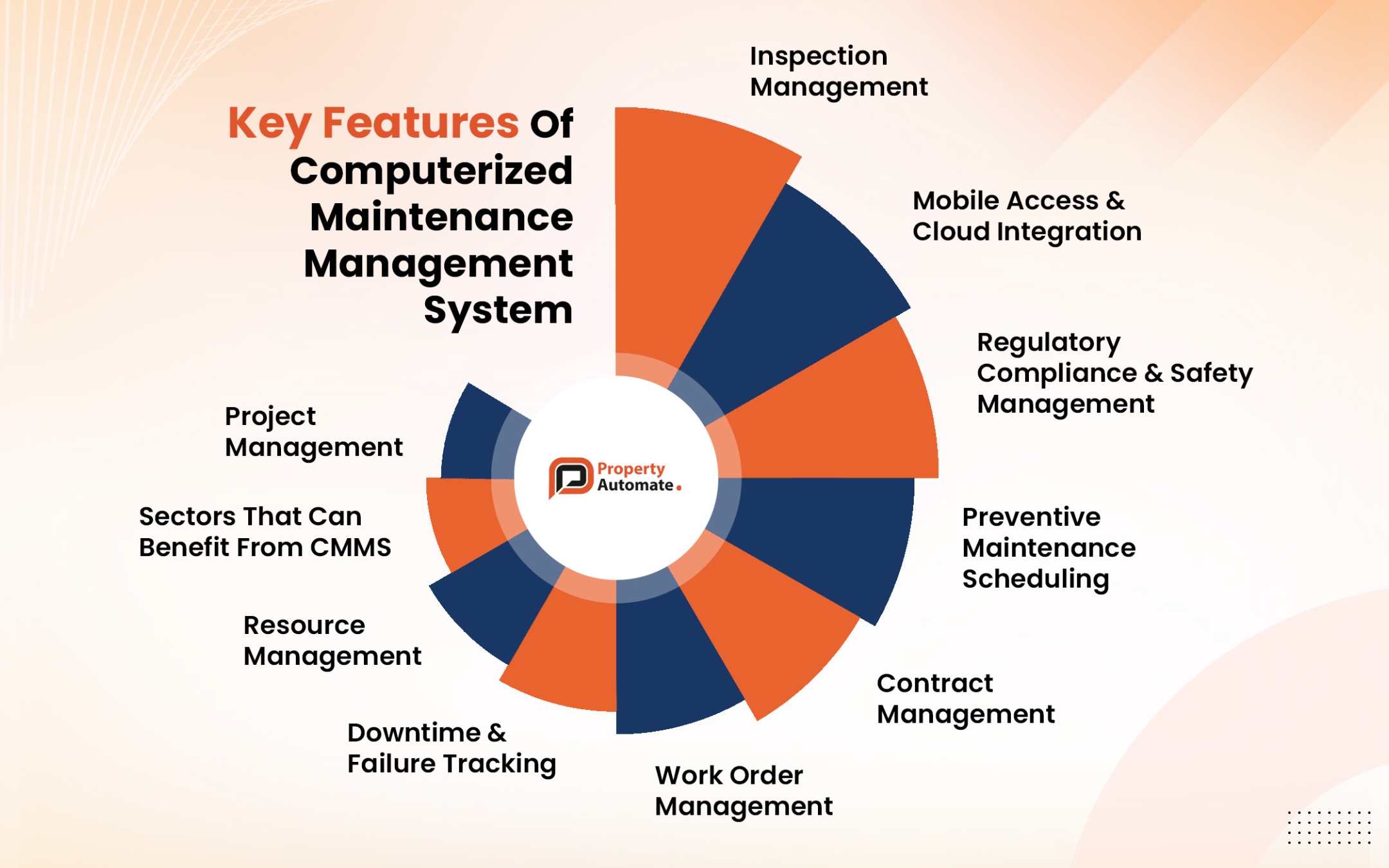CMMS Computerized Maintenance Management System – The Complete Guide
February 28, 2025
Facility

Meet us at Cityscape Global 2025, Riyadh, KSA
ExploreFebruary 28, 2025
Facility

A CMMS (Computerized Maintenance Management System) helps businesses streamline maintenance operations by managing work orders, tracking assets, scheduling preventive maintenance, ensuring regulatory compliance, improving efficiency and reducing downtime.
Organizations have implemented strategies to reduce downtime and improve efficiency from the beginning. After all, the essence of any business lies in being prepared. And, as long as people, machines, buildings, and equipment have been involved, we have continuously sought ways to monitor and streamline maintenance. The only difference is that in the past, maintenance relied on manual efforts, whereas today, CMMS (Computerized Maintenance Management Systems) has revolutionized the process.
CMMS is a software solution that automates maintenance workflows and enables businesses to operate seamlessly in the digital age. Today, we bring a comprehensive guide outlining everything you need to know about CMMS and how it can benefit you. So, without further ado, let's dive right in!
A CMMS is software designed to make maintenance easier by keeping all asset information in one place and automating tasks.
In the past, CMMS was installed on company computers or servers. But, with new technology, most CMMS platforms today are cloud-based. This means you can access them from a web browser or mobile app anytime, anywhere.
A CMMS helps businesses schedule, track, and manage maintenance efficiently. So, the risks of downtime are curbed and your operational efficiency is improved. With real-time data and insights, a CMMS ensures everything runs smoothly, and equipment lasts longer. To put it simply, CMMS keeps maintenance organized, automated, and hassle-free.
CMMS works by creating a database that organizes and manages information related to a business’s maintenance activities. It manages asset details, tracks work orders, schedules maintenance, manages inventory, provides reports, and more.
For instance, with asset management, CMMS stores equipment details, purchase dates, and maintenance history. This makes it easy for teams to access important information and plan maintenance efficiently.
The system also creates work orders when maintenance is needed, assigns tasks, and updates statuses in real time. So, you don't have to manually keep track of things. Instead, CMMS ensures smooth operations and timely task completion. From preventive maintenance scheduling to inventory management, it does it all.
Lastly, reporting and analytics provide real-time insights into maintenance performance and enable businesses to make smart decisions.
A CMMS helps businesses overcome several maintenance challenges. Take a look!
Equipment failures happen due to wear and tear, lack of maintenance, or unexpected issues like overheating or part failure. But with regular maintenance, you can prevent them. However, when you do it manually, missed schedules, human errors, and lack of tracking can lead to unexpected breakdowns. This unexpected downtime can slow down work and even lead to high repair costs.
However, a CMMS can help you navigate through this by scheduling regular maintenance based on time or usage. This ensures that equipment is checked, serviced, and repaired before it fails. With fewer unexpected failures, companies can save time, reduce costs, and improve efficiency while ensuring their equipment lasts longer and performs better.
When maintenance tasks are tracked manually, it's easy to miss deadlines, forget tasks, or lose important information. Even the most systematic individual can go through this. It then leads to delays, confusion, and unorganized workflows.
A CMMS solves this by creating and assigning work orders automatically. It keeps track of every task, sets priorities, and updates progress in real time. Technicians know exactly what needs to be done, and managers can monitor everything from one system.
When asset tracking is done manually, there are chances of information getting scattered. Even one person's error can make businesses lose track of maintenance history, warranties, and repair schedules.
However, with a computerized maintenance management system, you don't have to worry. A CMMS stores all asset details in one central system, making it easy to access and update.
Teams can quickly check an asset’s history, see past repairs, and plan future maintenance. With everything organized in one place, businesses can track, manage, and maintain assets effortlessly.
When a business runs out of spare parts, repairs get delayed, and equipment stays out of service longer. Manually tracking inventory can lead to missed restocks, shortages, etc. At the end of the day, this only leads to unnecessary downtime.
A CMMS helps by keeping track of inventory levels and sending alerts when parts are running low. It can even automate reorders so that essential supplies are always available when needed. This keeps everything running smoothly. You no longer have to deal with last-minute issues.
Creating manual reports can be time-consuming and hassle-some. And, there are chances of missing out on a few things. So, when you don't have the necessary insights on time, problems go unnoticed until they cause breakdowns.
A CMMS solves this by collecting and analyzing data on equipment performance, maintenance history, and repair trends. It generates reports and analytics so your team can identify issues early, improve efficiency, and reduce costs.
Now, let’s look at the main features of computerized management systems. These features help you make the most!
A CMMS makes inspections easier by tracking them in real-time and generating reports. It helps schedule safety and infrastructure checks so everything runs smoothly.
With detailed dashboards, your team gets instant updates on inspection status and the whole process becomes easy.
A CMMS automates maintenance schedules by sending reminders for routine tasks. This helps prevent unexpected breakdowns, extends equipment life, and reduces repair costs.
With regular servicing, businesses can keep operations running smoothly, reduce downtime, and focus on productivity instead of last-minute emergency fixes.

A CMMS simplifies work orders by managing all tasks in one system. It handles maintenance requests and makes sure all routine and emergency jobs are completed on time.
It also tracks pickup and delivery of resources, schedules showcase and site visits, and more so businesses stay organized and efficient.
With CMMS, businesses can track and manage their workforce, tools, and spare parts efficiently.
It assigns tasks based on technician availability and makes sure only the right resources are used. Therefore, the process becomes smooth and one doesn't have to worry about overuse or shortages.
This helps businesses optimize resource allocation as well as improve productivity.
Managing vendor and service contracts manually can be time-consuming. However, a CMMS keeps all contracts digitally organized.
This way, businesses stay compliant, avoid unexpected contract lapses, and maintain strong vendor relationships. So, in the long run, maintenance operations run like a well-oiled machine.
With CMMS, you can effortlessly plan and execute large maintenance projects in a hassle-free manner. The system helps you break tasks into steps, assign responsibilities, and track progress in real-time.
With clear timelines and automated updates, businesses can complete projects on schedule. Also, since everything is available on a single dashboard, the workflow becomes streamlined.
Tracking downtime and failures helps identify recurring problems and prevent costly breakdowns. A CMMS makes a note of when equipment fails, the cause of the issue, and how long it takes to fix it.
So, with this data handy, businesses can improve planning, reduce unexpected stops, and increase equipment reliability. In the long run, it also helps save costs.
With mobile access and cloud integration, you can manage maintenance tasks remotely. Businesses can create, track, and manage work orders, keep records of equipment and spare parts, track costs and time, and communicate with team members. This sense of flexibility improves operations and ensures absolute efficiency.
A CMMS helps businesses adhere to industry regulations by keeping detailed maintenance records and safety reports. It ensures all necessary inspections, certifications, and compliance tasks are completed on time.
When you have proper documentation, as an organization, you can avoid fines and meet all the necessary legal requirements.
While every business can benefit from CMMS, here are a few industries that need a computerized maintenance management system for hassle-free operations.
Manufacturing: CMMS keeps your machines running without unexpected breakdowns, so production stays on track.
Healthcare: The system makes sure that medical equipment is well-maintained and reduces any risks by preventing breakdowns.
Facilities Management: Here, it helps businesses stay on top of building maintenance, HVAC systems, and utilities to avoid major issues.
Hospitality: CMMS makes sure that hotel equipment, plumbing, and HVAC are in top shape, so guests have a seamless experience.
Education: The software makes sure classrooms, IT equipment, and school facilities are always in good condition for students and staff.
Energy & Utilities: It maintains power plants, pipelines, and water treatment systems to prevent any expensive failures.
Transportation & Logistics: It keeps fleets and warehouses running smoothly to make sure deliveries happen on time.
Food & Beverage: With CMMS, you can maintain restaurant equipment, refrigeration, and kitchen systems to meet health standards.
Choosing a CMMS is easy when you have the right blueprint in sight. These pointers can help guide you in the right direction.
You invest a lot of time, money, and effort into selecting the best machines and assets for your business. But keeping them running smoothly is just as important as choosing them. That’s where Computerized Maintenance Management Systems come in.
CMMS helps you track, maintain, and optimize your assets so they perform at their best for years.
With features like preventive maintenance, real-time monitoring, and data-driven insights, CMMS reduces downtime, lowers repair costs, and extends equipment lifespan.
By protecting your investments with an advanced system, you improve efficiency, reduce unexpected failures, and get the most value from your assets so your business keeps running strong.
If you are ready to take maintenance to the next level, invest in the right CMMS today!
1. Which is the best CMMS?
A: The best CMMS depends on your needs. For instance, you can try Property Automate . Look for features like mobile access, asset tracking, and preventive maintenance to find the right fit.
2. What is ERP and CMMS?
A: ERP (Enterprise Resource Planning) manages business processes like finance and HR, while CMMS (Computerized Maintenance Management System) focuses on asset maintenance. Some ERP systems include CMMS features for better overall management.
3. What are two types of CMMS?
A: The two main types are cloud-based CMMS, which allows remote access from any device, and on-premise CMMS, which is installed on local servers for full internal control.
4. Is EAM the same as CMMS?
EAM (Enterprise Asset Management) and CMMS (Computerized Maintenance Management System) are similar but not the same. CMMS focuses on maintenance whereas EAM covers the entire asset lifecycle.
